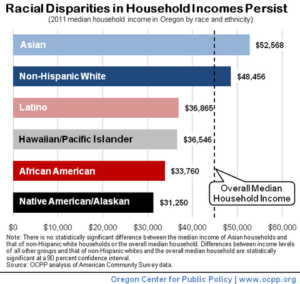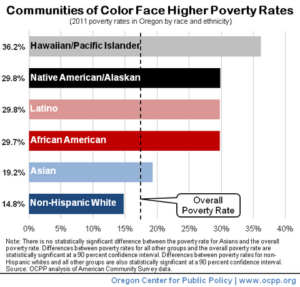Poverty and Median Household Income in Oregon by Race and Ethnicity
There is another thing closely related to racism that I would like to mention as another challenge. We are challenged to rid our nation and the world of poverty. — Rev. Dr. Martin Luther King Jr., March 1968
In the last years of his life, Rev. Dr. Martin Luther King Jr. waged a campaign to end economic inequality and poverty. Dr. King understood that that these economic ills affected Americans of all races, especially African Americans and other minorities. He recognized that the nation possessed the resources and ability to solve problems such as poverty. “The real question,” Dr. King observed, “is whether we have the will.”[1]
Four decades after Dr. King’s death, racial and ethnic minorities still typically earn less income than whites and suffer higher poverty rates than whites.

In 2011, the typical (median) Oregon household earned $46,816.[2] But, with the exception of Asians, the income of typical households of color significantly lagged that of the typical non-Hispanic white household.
There was no statistically significant difference between the median household income of Asians and that of non-Hispanic whites. The typical white household’s income exceeded the incomes of the typical Latino, Native Hawaiian/Pacific Islander, African American and Native American households by about $12,000 or more. To put that disparity in perspective, $12,000 was more than enough to cover a year’s worth of tuition and fees at any school within the Oregon University System.[3]

In 2011, 17.5 percent of all Oregonians lived in poverty. As bad as the poverty rate was for Oregon as a whole, it was worse among Oregonians of color than in non-Hispanic white communities.
In 2011, the poverty rate for non-Hispanic whites in Oregon was 14.8 percent. By contrast, it was 19.2 percent for Asians, 29.7 percent for African Americans, 29.8 percent for Native Americans and 29.8 percent for Latinos, and 36.2 percent for Native Hawaiian/Pacific Islanders.
Put another way, while about 1 out of every 7 Oregon non-Hispanic whites lived in poverty in 2011, nearly 1 in 5 Asians, almost 1 in 3 African Americans, Native Americans and Latinos, and over 1 in 3 Native Hawaiian/Pacific Islanders lived below the poverty line that year.
Conclusion
Dr. King’s dream to end economic inequality and poverty remains distant. In Oregon, the income of the typical household of all but one community of color significantly lags that of non-Hispanic whites. And poverty rates among communities of color are especially high.
[1] King, Martin Luther, “Remaining Awake Through a Great Revolution,” March 31, 1968.
[2] Unless otherwise noted, all calculations in this fact sheet are based on OCPP analysis of American Community Survey data and represent estimates based on that data.
[3] For the 2011-12 academic year, the average tuition and fees for in-state residents was $7,605, books and supplies averaged $1,473, personal expenses (including transportation) averaged $2,692, and room and board averaged $9,163. The additional $12,000 in median household income is enough to cover tuition and fees as well as books and supplies at each institution. On average, after using that additional income to pay for tuition, fees, books and supplies, a household would still have about $2,900 to devote to personal expenses or room and board. For a detailed breakdown for each institution, see Oregon University System, Facts and Figures, 2011, p. 63.








